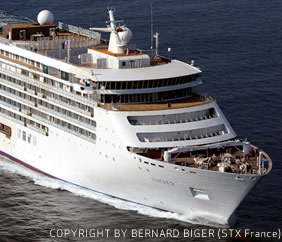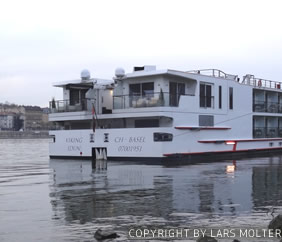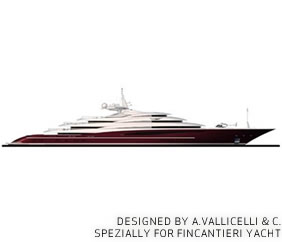Ocean Cruiser

Ocean cruise ships offer the opportunity to use sophisticated alternative technologies to reduce the emissions of pollutants and greenhouse gases. The chosen baseline for Ocean cruise ship is an “Exploration” vessel. This luxurious vessel aims at exploring new locations where the protection of environment is highly sensitive. Fitted with 12 decks, the ship can host 850 passengers and 400 crew members, and reach 19 knots. The hull design gives an overall length of 230m for 27m breadth, and a design draught of 6m.
Read more ...River Cruiser

The market for Inland waterway passenger vessels (in the following “river cruiser”) is growing continuously since the past 10 years (DRV – Kreuzfahrtmarkt Deutschland 2010). Correspondingly the fleet attains growth of approximately 10 vessels per year. Today, the European fleet offers the second biggest bed capacity of the world, after Egypt but just in front of Russia/Ukraine. The ships are operated on the main waterways of central Europe and take port in the city centres of some of the most important touristic capitals. They are therefore flagships of the white industry and offer a great opportunity to proof to the society that sustainability is more than a buzzword for European shipyards.
A river cruiser is especially designed for sailing on inland waterways like rivers, lakes and channels. The offered standard in Europe is hereby comparable to the one offered on modern ocean going passenger vessels. A river cruiser transports passengers to several cities along a defined route. Usually the journey is a round trip. The cruise length varies but most common is a trip of 5 to 7 days.
Propulsion train concept on modern river cruiser is two diesel engines driven steering propeller, where diesel engine and steering propeller are coupled together with a remote operated cutch. Electric power is provided by two or three separate Generator sets. Thermal energy is provided by boilers, thermal energy of engines is not used today. In exhaust gas systems are equipped with filter for black carbon where required. Some cities are already offering shore power for cold ironing to reduce not only air emissions and noise, but most of the ships are not prepared to use it.
The propulsion diesel engines are designed for river upstream conditions and optimized therefore. This means that for downstream cruising they are running in very none efficient mode. HVAC systems as biggest none propulsion consumer are mainly installed in constant flow technology with combined heating /cooling circles, local reheated to control the room or area temperature.
Mega Yacht

Mega Yachts combine extreme attention to beauty and technology. Owners are requiring the highest quality and comfort standards available on the market.
The “Baseline Project” used as benchmark in the research project is a 140 m luxury motor yacht.
The propulsion system of the yacht is diesel electric and distribution is in alternating current . The yacht is provided high luxury accommodations for up to 26 passenger. Accommodations are also provided for 57 crew and staff, in compliance with the latest MLC rules. Huge open areas are avallabile at all decks.
Read more ...





